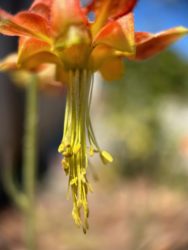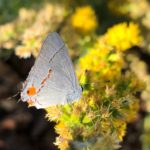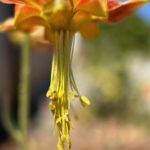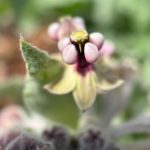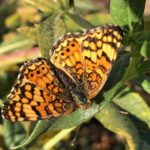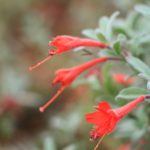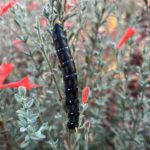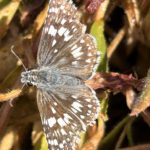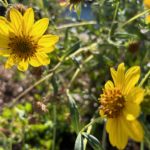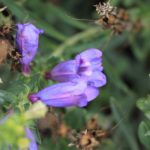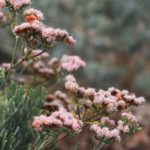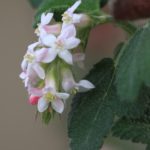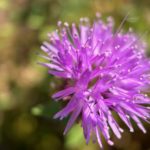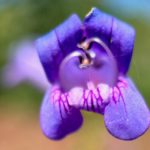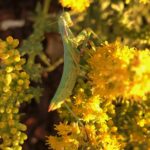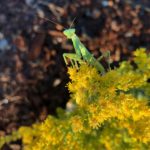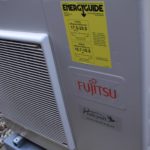Lot size: 1,300 sq. ft. front garden
Garden Age: The native garden was installed in stages, beginning in 2021
Years on the Bringing Back the Natives Garden Tour: New this year!
Showcase Feature
When long-time Tour-goer Laura and her husband bought the house in 2021 one of the first projects they tackled was the front yard, which consisted of a weedy lawn bordered by rosemary hedges and nandina (which bears cyanide-containing berries that are toxic to birds).
The garden was designed by Kelly Marshall of Kelly Marshall Garden design free-of-charge, through the Contra Costa Water District’s Landscape Design Assistance Program, and the family received a $600 rebate from the District through its Lawn to Garden program for sheet mulching the lawn away, installing drip irrigation in part of the garden, and planting with natives. The garden was installed by Laura and her family.
A pleasing variety of perennial California lilac, manzanitas, lupine, sages, buckwheats and bunchgrasses anchor this peaceful garden. Yellow goldenrod and sunflowers, purple penstemon and coyote mint, cream-colored yarrow, lavender seaside daisy, and fire-engine red fuchsia brighten the landscape at various times of the year.
Other Garden Attractions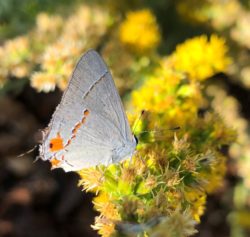
• Weeds are hand-pulled; if that doesn’t do them in, hot water poured is on them, and, if necessary, rocks are piled on the ground where they would reappear. No pesticides are used in this—or any!—Tour garden.
• Laura works for the land trust and conservation organization Save Mount Diablo, as does Concord garden tour host Juan Pablo Galván Martínez; information on Save Mount Diablo will be available at their gardens.
Gardening for Wildlife
Laura asked Kelly design a garden that would attract birds, bees, and butterflies; as you can see from the photographs, Kelly did. Native bees love the native wildflowers; Valley carpenter bees—the largest bees in California—and small, shiny, green sweat bees frequent the garden.
Diminutive grey hairstreaks, reddish orange Mylitta crescents, and sturdy skippers flit about, sipping nectar and pollinating flowers. As many butterflies and moths overwinter beneath fallen leaves, leaf litter is left on the ground.
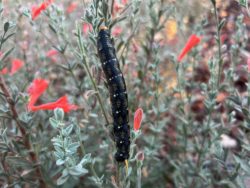 Hummingbird moths lay eggs on the native fuchsia—don’t miss the beautiful photograph of the beautiful black and gold hummingbird moth caterpillar on a native fuchsia in Laura’s set of photos. Moths, like butterflies, can only lay their eggs on specific plants; plants that the hummingbird moth can reproduce on include native fuchsia, buckwheat, currants, hollyleaf cherry, and clarkia.
Hummingbird moths lay eggs on the native fuchsia—don’t miss the beautiful photograph of the beautiful black and gold hummingbird moth caterpillar on a native fuchsia in Laura’s set of photos. Moths, like butterflies, can only lay their eggs on specific plants; plants that the hummingbird moth can reproduce on include native fuchsia, buckwheat, currants, hollyleaf cherry, and clarkia.
Lesser goldfinches nibble the seeds of the California sunflowers, and hummingbirds sip nectar from the California fuchsia and chaparral currant.
Keystone species (watch this talk by Doug Tallamy!)
Keystone species—our own, local ecological powerhouse plants— in this garden include California lilacs, currants, manzanitas, lupines, buckwheats, sages, California sunflowers, California rose, goldenrod, and penstemon.
Green Home Features
Come on into this fully electrified home! The climate crisis motivated Laura and her husband to take action to reduce their contribution to global warming.

Solar panels create the energy needed to power 108 percent of their annual electricity use. Their home now runs on 100 percent electricity, and both their cars are electric.
As a gas furnace can cost almost half of a home’s total energy usage, theirs was replaced by Eco Performance Builders with a Fujitsu ducted heat pump system, which both heats and cools the house.
The family received a $605 lawn-removal rebate and free landscaping design assistance from the District.
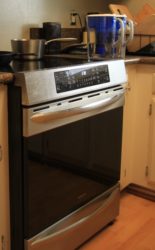 The Frigidaire Galaxy induction stovetop means the family is no longer breathing in dangerous chemicals produced by gas-burning stoves. (See this NY Times article “Study Compares Gas Stove Pollution to Secondhand Cigarette Smoke”.) Clean-up is a breeze with the stove’s flat top, and food and water heat up more quickly on an induction stove than on when that burns gas. Laura is also happy with her electric LG dryer.
The Frigidaire Galaxy induction stovetop means the family is no longer breathing in dangerous chemicals produced by gas-burning stoves. (See this NY Times article “Study Compares Gas Stove Pollution to Secondhand Cigarette Smoke”.) Clean-up is a breeze with the stove’s flat top, and food and water heat up more quickly on an induction stove than on when that burns gas. Laura is also happy with her electric LG dryer.
The house has a cool roof, which reflects sunlight and disperses heat, and stay cooler than a conventional roof. This keeps the house cooler, of course, but it also saves energy and money. Laura’s roofer, A Better Roofing Company, was willing to install the cool roof for a very reasonable price and at the same cost as a conventional roof.
Between the solar panels and electrification efforts, the family is now saving money on their PG&E bill.
Laura and her husband got a below-market interest rate from the State of California through Go Green Financing to pay for the electrification work. The goal of Go Green Financing is to reduce greenhouse gas emissions and address climate change. They got also a solar loan from Redwood Credit Union.
Wondering what to make for dessert tonight?
Best-Ever Pumpkin Muffins
At least partially wheelchair accessible? Yes
Best Ever Pumpkin Muffins (Gluten-free or regular flour)
Best-Ever Pumpkin Muffins


